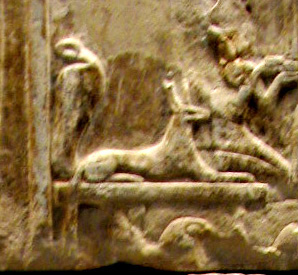

|
I've found several quotes of inscriptions featuring Set on statuary, but have not as yet found images of the particular pieces. So this is the page for those. Also this is the spot for fragments and other miscellanea. On my visit in May of 2009, I was impressed by the relief at the Met museum from the Chapel built by Seti I for his Father Ramesses I. I took a few photos of it, and it wasn't until a few months later when I was preparing the photos for the online gallery that I noticed the appearance of a Set sha (or animal):
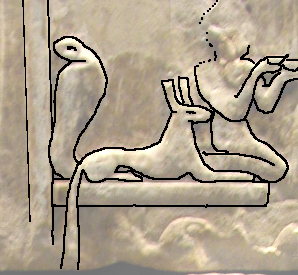
"The most remarkable of these was found in the southern half of the temple, in the form of a small statue (Fig. 1). It lay
close to the southern central column surrounded by wind-blown sand, at about 30 cm above the original floor level...
"The statue attests the long-lasting veneration of the god Seth in the Dakhleh Oasis...
"The statue is made of limestone and its current height measures 28 cm, its base 14x22cm. It is in a severely damaged
state; the head is missing as well as the hands, arms and feet, while the remaining surface is chipped on all sides..." (page 231)
Despite all the damage, some of its inscription is still visible:
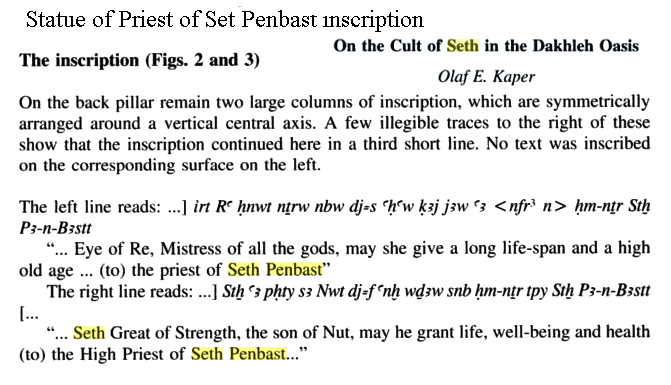 The left line reads: "... Eye of Re, Mistress of all the gods, may she give a long life-span and a high old age ...(to) the priest of Seth Penbast" The right line reads: "..Seth Great of Strength, the son of Nut, may he grant life, well-being and health (to) the High Priest of Seth Penbast..." (page 232)
The first brought forth an interesting stela with this footnote: "The 'Two Lords are Horus and Seth", whereby it is referencing this sentence: "May you inhale myrrh and ointment and receive the cleansing of the Two Lords." I agree with Lichtheim's conclusion "Of special interest in his autobiography is Nebneteru's expression of satisfaction with his exceptionally long life, and his emphatic exhortation to the reader to enjoy life, to eschew worries, and to shun the thought of death." (pages 18 -24)
Ancient Egyptian Literature: Volume III: The Late Period is not expensive, I might add that to my collection someday. I noted further references to Set in Lichtheim's Ancient Egyptian Literature: The New Kingdom / with a new foreword regarding Ramses II's Kadesh battles in which "he was like Seth in the moment of his power," and "His majesty was like Seth, great-of-strength, like Sahkmet in the moment of her rage..." and in the poem of Ramses II praising him, "Great of awe, rich in glory, As is Seth upon his mountain..."((Pages 57 to 63) Then, I am not sure how I ended up at the rest of my findings. I wanted to see a photo of Nebneteru's "block statue of grey granite", and did not, only a reference to it that said it was from the 22nd Dynasty and came from the 'Karnak cachette'. Somehow I ended up at Ramesside Inscriptions, Translated and Annotated Translations: Ramesses II... by Kenneth A. Kitchen, a 300 buck book which I won't be acquiring any time soon. One nice Set sighting is the following: |
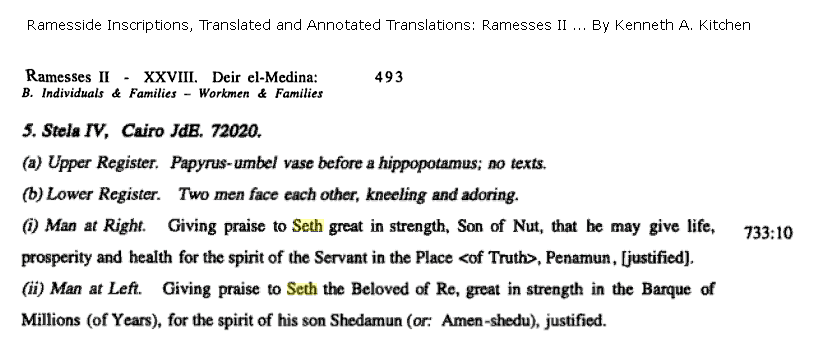
|
5. Stela IV, Cairo JdE. 72020 (a) Upper Register. Papyrus-umbel vase before a hippopotamus; no texts. (b) Lower Register. Two men face each other, kneeling and adoring. (i) Man at Right. Giving praise to Seth great in strength, Son of Nut, that he may give life, prosperity and health for the spirit of the Servant in the Place <of Truth>, Penamun, [justified]. (ii) Man at Left. Giving praise to Seth the Beloved of Re, great in strength in the Barque of Millions (of Years), for the spirit of his son Shedamun (or: Amen-shedu), justified. |
|
I've found another reference to this stela. It is: Stela, dedicated to Seth by Penamun and Amenshed, in Cairo, Egyptian Museum, JE 72020. Thebes. Deir el-Medîna. Miscellaneous. Stelae.i2.731
Apparently a book by a "Bruyère, Rapport (1935-40), fasc. ii, 101-2 [228] fig. 173 and pl. xvi." has an illustration of it. I find also, "The village was first excavated early this century by Ernesto Schiaparelli, but considerable valuable work was carried out later by Bernard Bruyere and Jaroslav Cerny....Bruyère for the French Institute in Cairo in 1922-1940 and 1945-1951." But no photos.
I did find another Ramesside inscription which speaks of Set. Setau, the viceroy of Kush, in the lower scene of this stela is:
This inscription was also translated by Kenneth Kitchen and is on a stela at the Cairo museum, 41396.
|
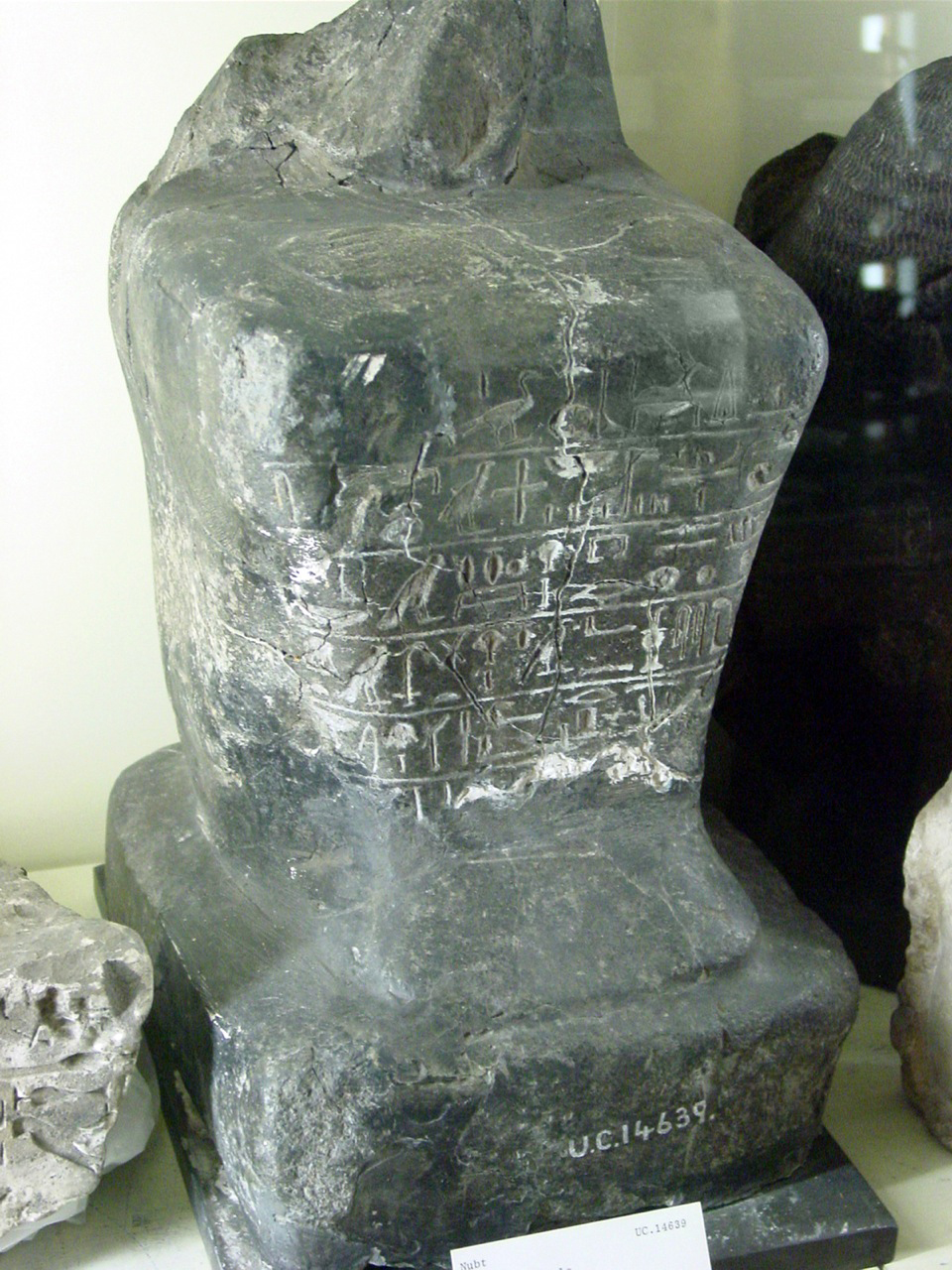
|
"Given as a reward from the king in the temple of Nubti to the prince of the southern city Sen-nefer," and below, "May the king give an offering and Set of Nubit, son of Nut, very valorous, at the front of the sacred bark; and all the gods who are in Nubt, may they grant the receiving of food that appears upon the altar, of every good and pure thing, the offering of frankincense on the censer daily, to the Ka of the hereditary prince, the watchful overseer, who loves his lord, the steward of . . . prince of the southern city
Sen-nefer, devoted to his lord, makheru." Naqada and Ballas by Petrie Makheru, aka Maa-kheru means 'true of voice', KA refers to an aspect of the immortal soul More items from Naqada Temple of Seth The Oriental Museum has a small stela featuring Set as a hippopotamus and Panehmy with hands outstetched towards Set:
  
|